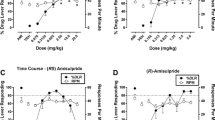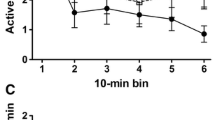Abstract
The discriminative stimulus (DS) and subjective effects of caffeine (100 and 300 mg, PO) and benzphetamine (12.5 and 50 mg, PO) were studied in 18 normal human volunteers trained to discriminate between d-amphetamine (10 mg) and placebo. d-Amphetamine increased ratings of drug liking and activity level and produced a profile of subjective effects characteristic of amphetamine and related psychomotor stimulants. The DS effects of d-amphetamine generalized only partially to caffeine and benzphetamine; mean percent d-amphetamine-appropriate responding was 42 and 58 after 100 and 300 mg caffeine, respectively, and 17 and 56 after 12.5 and 50 mg benzphetamine, respectively. Neither dose of caffeine affected ratings of drug liking or activity level, but 300 mg caffeine did produce a profile of subjective effects that partially overlapped with that produced by d-amphetamine. Benzphetamine 50 mg, but not 12.5 mg, increased ratings of drug liking and activity level and produced a profile of subjective effects qualitatively similar to, but weaker than, that produced by d-amphetamine. For both caffeine and benzphetamine, a close relationship was observed between their subjective effects and their ability to substitute for the DS effects of d-amphetamine. These results correspond well with findings obtained from similar studies conducted with laboratory animals, providing further support for the reliability and validity of human drug discrimination paradigms.
Similar content being viewed by others
References
Bruce M, Scott N, Lader M, Marks V (1986) The psychopharmacological and electrophysiological effects of single doses of caffeine in healthy human subjects. Br J Clin Pharmacol 22:81–87
Chait LD, Griffiths RR (1983) Effects of caffeine on human cigarette smoking behavior and subjective response. Clin Pharmacol Ther 34:612–622
Chait LD, Uhlenhuth EH, Johanson CE (1985) The discriminative stimulus and subjective effects of d-amphetamine in humans. Psychopharmacology 86:307–312
Chait LD, Uhlenhuth EH, Johanson CE (1986a) The discriminative stimulus and subjective effects of d-amphetamine, phenmetrazine and fenfluramine in humans. Psychopharmacology 89:301–306
Chait LD, Uhlenhuth EH, Johanson CE (1986b) The discriminative stimulus and subjective effects of phenylpropanolamine, mazindol and d-amphetamine in humans. Pharmacol Biochem Behav 24:1665–1672
Chait LD, Uhlenhuth EH, Johanson CE (1987) Reinforcing and subjective effects of several anorectics in normal human volunteers. J Pharmacol Exp Ther 242:777–783
Chait LD, Evans SM, Grant KA, Kamien JB, Johanson CE, Schuster CR (1988) Discriminative stimulus and subjective effects of smoked marijuana in humans. Psychopharmacology 94:206–212
Charney DS, Galloway MP, Heninger GR (1984) The effects of caffeine on plasma MHPG, subjective anxiety, autonomic symptoms and blood pressure in healthy humans. Life Sci 35:135–144
Cole JO, Pope HG, LaBrie R, Ionescu-Pioggia M (1978) Assessing the subjective effects of stimulants in casual users. A methodology and preliminary results. Clin Pharmacol Ther 24:243–252
Colpaert FC, Slangen JL (eds) (1982) Drug discrimination: applications in CNS pharmacology. Elsevier, Amsterdam
Cox RH, Maickel RP (1972) Comparison of anorexigenic and behavioral potency of phenylethylamines. J Pharmacol Exp Ther 181:1–9
de la Garza R, Johanson CE (1987) Discriminative stimulus properties of intragastrically administered d-amphetamine and pentobarbital in rhesus monkeys. J Pharmacol Exp Ther 243:955–962
Dixon WJ (ed) (1983) BMDP statistical software. University of California Press, Berkeley
Evans SM, Johanson CE (1987) Amphetamine-like effects of anorectics and related compounds in pigenons. J Pharmacol Exp Ther 241:817–825
Goldstein A, Kaizer S, Warren R (1965) Psychotropic effects of caffeine in man. II. Alertness, psychomotor coordination, and mood. J Pharmacol Exp Ther 150:146–151
Griffith JD (1977) Structure-activity relationships of several amphetamine drugs in man. In: Ellinwood EH, Kilbey MM (eds) Cocaine and other stimulants. Plenum Press, New York, pp 705–715
Holloway FA, Michaelis RC, Huerta PL (1985) Caffeine-phenylethylamine combinations mimic the amphetamine discriminative cue. Life Sci 36:723–730
Kuhn DM, Appel JB, Greenberg I (1974) An analysis of some discriminative properties of d-amphetamine. Psychopharmacologia 39:57–66
Martin WR, Sloan JW, Sapira JD, Jasinski DR (1971) Physiologic, subjective and behavioral effects of amphetamine, methamphetamine, ephedrine, phenmetrazine, and methylphenidate in man. Clin Pharmacol Ther 12:245–258
McNair DM, Lorr M, Droppleman LF (1971) Manual for the Profile of Mood States. Educational and Industrial Testing Service, San Diego
Overton DA (1984) State dependent learning and drug discriminations. In: Iversen LL, Iversen SD, Snyder SH (eds) Handbook of psychopharmacology, vol 18. Plenum Press, New York, pp 59–127
Rall TW (1985) Central nervous system stimulants. The methylxanthines. In: Gilman AG, Goodman LS, Rall TW, Murad F (eds) The pharmacological basis of therapeutics. Macmillan, New York, pp 589–603
Rosen JB, Young AM, Beuthin FC, Louis-Ferdinand RT (1986) Discriminative stimulus properties of amphetamine and other stimulants in lead-exposed and normal rats. Pharmacol Biochem Behav 24:211–215
Schuster CR, Johanson CE (1988) The relationship between the discriminative stimulus properties and subjective effects of drugs. In: Colpaert FC, Balster RL (eds) Transduction mechanisms of drug stimuli. Springer, Berlin Heidelberg New York Tokyo, pp 161–175
Weiner N (1985) Norepinephrine, epinephrine, and the sympathomimetic amines. In: Gilman AG, Goodman LS, Rall TW, Murad F (eds) The pharmacological basis of therapeutics. Macmillan, New York, pp 145–180
Weiss B, Laties VG (1962) Enhancement of human performance by caffeine and the amphetamines. Pharmacol Rev 14:1–36
Author information
Authors and Affiliations
Rights and permissions
About this article
Cite this article
Chait, L.D., Johanson, C.E. Discriminative stimulus effects of caffeine and benzphetamine in amphetamine-trained volunteers. Psychopharmacology 96, 302–308 (1988). https://doi.org/10.1007/BF00216054
Received:
Revised:
Issue Date:
DOI: https://doi.org/10.1007/BF00216054




